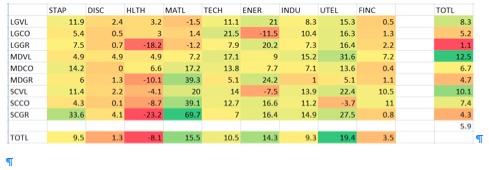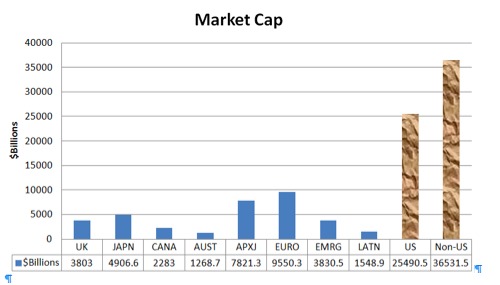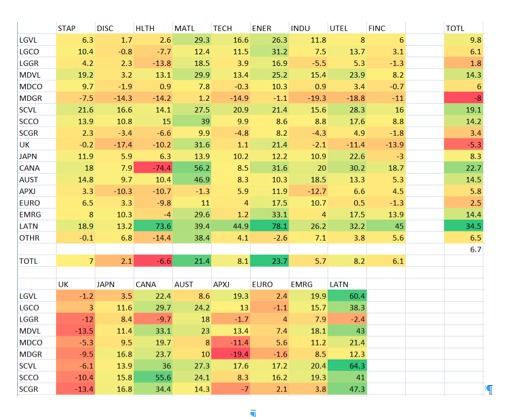As we wrap up 2016, there’s still time to improve your portfolios.
Heat maps can help by identifying segments of the market that have been performing well (green) and those that have been performing poorly (red).
Then we can decide if performance will continue (momentum) or reverse (regression to the mean).
U.S. Stock Market
Here are some observations from the following heat map for the U.S stock market.

Smaller-cap value stocks have performed well, as have telecoms and utilities, materials and energy.
Growth stocks have performed poorly, as have healthcare and consumer discretionary companies.
The best performing market segment has been small-cap growth companies in the materials sector with a 69.7% return. The worst performer: small-cap growth stocks in the healthcare sector with a 23.2% loss.
Smart Beta
I personally anticipate a reversal in small company value stocks because they’ve been propelled by the popularity of “smart beta,” which is essentially a bet on small-cap value companies.
Lured by the prospect of outperforming the markets (as measured by capitalization-weighted indexes), investors have flocked to smart beta indexes, driving them to exceed $500 billion, which is about 20% of all US exchange-traded product.
In my opinion, the lemmings may have once again demonstrated that their stampeding can turn a potentially smart buy into something really stupid.
So says Rob Arnott et al in their February 16, 2016 explanation of How Can “Smart Beta” Go Horribly Wrong?
Arnott is founder and owner of Research Affiliates, the developer of the very first smart beta indexes called “RAFI” for Research Affiliates Fundamental Indexes.
Here’s what they say:
“We foresee the reasonable probability of a smart beta crash as a consequence of the soaring popularity of factor-tilt strategies.
Performance chasing, the root cause of many investors’ travails, has three inextricably linked components. Rising valuation levels of a stock, sector, asset class, or strategy inflate past performance and create an illusion of superiority.
At the same time, rising valuations reduce the future return prospects of that stock, sector, asset class, or strategy, even if the new valuation levels hold. Finally, the higher valuations create an added risk of mean reversion to historical valuation norms.
Is the financial engineering community at risk of encouraging performance chasing, under the rubric of smart beta? If so, then smart beta is, well, not very smart.”
But as shown in the following graph, it’s a big world, and the U.S. stock market is only 40% of it. There’s plenty more opportunity outside the U.S.

Foreign Stocks
Here are some observations from the following heat map:

- Like in the US, smaller-cap value stocks have performed well while growth stocks have performed poorly. Since smart beta investing has spread outside the US, we might expect a reversal here too.
- Materials and energy stocks have performed well, while healthcare and consumer discretionary have performed poorly.
- Latin America and Canada have performed best, while Europe has lagged. As a result, the total foreign market return of 6.7% exceeds the MSCI EAFE Index’s -0.4% loss. EAFE has been easy to beat if the mandate includes Canada and/or Latin America.
- The best segment has been energy stocks in Latin America with a 78.1% return, and the worst is healthcare companies in Canada with 74.4% loss




